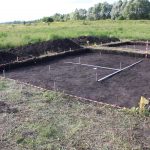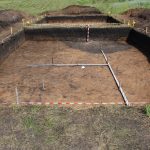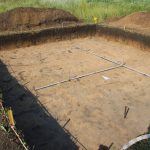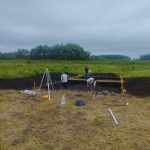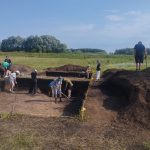Archaeological research at the Narovchat settlement (the city of Mukhshi) in the Penza region
The Institute of Archaeology named after A.Kh. Khalikov of the Tatarstan Academy of Sciences jointly with the Institute for Regional Development of the Penza Oblast, conducted archaeological excavations at the Narovchat settlement (the city of Mukhshi) in the Penza Oblast. Schoolchildren from the city of Penza participated in the work. Representatives of the regional public organization “Tatar National-Cultural Autonomy of the Penza Oblast” showed particular interest in the comprehensive historical and archaeological research at the site. Specifically, Rinat Abuziarov, a member of the Presidium of the Executive Committee of this organization, visited the excavations in the village of Narovchat.
The archaeological research was conducted as a part of the state program of the Republic of Tatarstan “Preserving the identity of the Tatar people (2020-2025)”. This program aims to conduct historical and archaeological research on medieval cities and study the historical and cultural Turkic-Tatar heritage outside the Republic of Tatarstan.
The Narovchat settlement is associated with the Golden Horde city of Mukhshi. Founded in the early XIV century in a
region inhabited by Burtas, Bolgars, and Mordvins, Mukhshi became the capital of the Golden Horde during the reign of Uzbek Khan.During the 2025 field season, excavations covered an area of 96 square meters in the western part of the settlement, on a section identified as an anomaly according to the geophysical survey results. The key discovery is a sub-rectangular structure measuring 2×4 meters, found at the level of the 3rd cultural layer. The structure’s fill consists of dark gray, dense sandy loam with inclusions of burned brick, ash, and charcoal.
Among the archaeological finds, tentatively dated to the XIV century, were industrial waste (slag fragments), fragments of red-clay wheel-made ware from the Golden Horde period, over 10 copper coins, and various household and craft items such as knives, bracelets, locks with keys, buckles, decorative plates, and spindle whorls, as well as a large quantity of animal bones.
Preliminary conclusions indicate that the discovered artifacts date to the XIV century, confirming the hypothesis that the Golden Horde city of Mukhshi was located at this site. Research at the Narovchat settlement contributes to a better understanding of the history of the Golden Horde, the lifestyle and culture of Mukhshi’s residents, and the interaction of various ethnic groups in the region.

